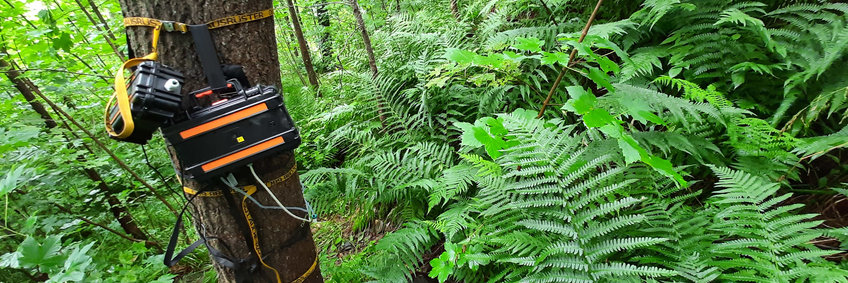Department Biogeochemical Processes
Prof. Trumbore
The Biogeochemical Processes Division studies key processes and organisms that regulate the exchange of energy, water, and chemical compounds between ecosystems and their environments, and how these processes are affected by changes in climate and land use.
Within this broad goal, the Department maintains a focus on processes that are critical to understanding feedbacks between the land carbon cycle and climate and where lack of fundamental understanding currently limits the ability to predict the role of land as a source or sink for carbon in the coming decades to centuries. Broadly, the research in the Department shares the common goal to investigate processes that control how long carbon resides in ecosystem compartments, at spatial scales that span organisms to landscapes. Because of the importance of carbon to living organisms in storing energy and building structures, these processes are also fundamental to the functioning of ecosystems and their response to change.
At the organism (microbe or plant) scale, we investigate how environmental controls such as drought or substrate availability influence resource allocation and activity in ways that can alter the timescales of carbon storage. At the ecosystem scale, we investigate how biotic (e.g. community diversity) and abiotic factors (mineralogy or climate) alter land-atmosphere exchange and the timescales for stabilization or destabilization of C in soils. At the landscape scale, we assess how disturbance processes such as fire, drought, windthrow and herbivory, can alter ecosystem carbon stocks and cycling.
Approaches and Tools
Quantifying responses and feedbacks in complex, coupled systems requires a range of tools and approaches. Laboratory experiments manipulate individual factors such as temperature, biodiversity or nutrient availability to document how different components of the ecosystem respond to changing environmental conditions. We participate in large field experiments that manipulate biodiversity (Jena experiment) and disturbances such as fire (Tanguro experiment). Field observations of gradients of biodiversity through land management (Biodiversity Exploratories), or windthrows (ATTO) provide long-term field ‘experiments’. Links to our own Theory group, as well as other modeling groups in the Institute allow us to use our results to test theories/models of ecosystem/organism function. We also actively develop new analytical tools that allow us to evaluate the importance of processes across a range of spatial and temporal scales.
Recent Publications
González-Armas, R.; Rikkers, D.; Hartogensis, O.; Dias-Júnior, C. Q.; Komiya, S.; Pugliese, G.; Williams, J.; van Asperen, H.; de Arellano, J. V.-G.; de Boer, H. J.: Daytime water and CO
2 exchange within and above the Amazon rainforest. Agricultural and Forest Meteorology
372, 110621 (2025)
Nel, T.; Clarke, C. E.; Francis, M. L.; Sakala, B.; Breecker, D. O.; Gallagher, T.; Sierra, C.: Impacts of land use change on carbon storage in termite mounds of South Africa. Catena
257, 109141 (2025)
Huth, F.; Tischer, A.; Nikolova, P.; Feldhaar, H.; Wehnert, A.; Hülsmann, L.; Bauhus, J.; Heer, K.; Vogt, J.; Ammer, C. et al.; Berger, U.; Bernhardt-Römermann, M.; Böhme, M.; Bugmann, H.; Buse, J.; Demant, L.; Dörfler, I.; Ewald, J.; Feldmann, E.; Fichtner, A.; Gossner, M. M.; Grams, T. E. E.; Haberle, K.-H.; Hagge, J.; Hartmann, H.; Herzog, S.; Kahmen, A.; Kohnle, U.; Krabel, D.; Krämer-Klement, K.; Kreyling, J.; Manthey, M.; Mellert, K.; Meyer, P.; Mölder, A.; Muffler-Weigel, L.; Ohse, B.; Opgenoorth, L.; Rewald, B.; Rothe, A.; Ruehr, N.; Scharnweber, T.; Scherer-Lorenzen, M.; Schmeddes, J.; Schmerbeck, J.; Schmidt, M.; Seidel, D.; Thomas, F. M.; Tiebel, M.; von Oheimb, G.; Wagner, S.; Weigel, R.; Wilmking, M.; Zang, C.; Schuldt, B.: Ecological assessment of forest management approaches to develop resilient forests in the face of global change in Central Europe. Basic and Applied Ecology
86, pp. 66 - 100 (2025)
Khanam, T.; Peris-Llopis, M.; Selkimäki, M.; Brazaitis, G.; Mola-Yudego, B.; Hartmann, H.; Curtu, A. L.; Hălălișan, A.-F.; Marjanovic, Ž.; Leskinen, L. et al.; Pantera, A.; Djahangard, M.; Yousefpour, R.; Brazaityte, G.; Kukobat, L.; Trivan, G.; Mao, Z.; Brusselen, J. V.; Berninger, F.: Navigating climate threats in forestry across five European regions: Stakeholder's adaptive management and policy strategies to resilience. Journal of Environmental Management
388, 125903 (2025)
Botia, S.; Munassar, S.; Koch, F.-T.; Custódio, D.; Basso, L. S.; Komiya, S.; Lavric, J. V.; Walter, D.; Gloor, M.; Martins, G. et al.; Naus, S.; Koren, G.; Luijkx, I.; Hantson, S.; Miller, J. B.; Peters, W.; Rödenbeck, C.; Gerbig, C.: Combined CO
2 measurement record indicates Amazon forest carbon uptake is offset by savanna carbon release. Atmospheric Chemistry and Physics
25 (12), pp. 6219 - 6255 (2025)
Robin, M.; Durgante, F. M.; Mallmann, C. L.; Hadlich, H. L.; Römermann, C.; de Falcão, L. S.; Lacerda, C. D.; Duvoisin Jr., S.; Wittmann, F.; Piedade, M. T. F. et al.; Schöngart, J.; Gomes Alves, E.: Leaf spectroscopy as a tool for predicting the presence of isoprene emissions and terpene storage in central Amazon forest trees. Plant Methods
21, 78 (2025)
Sierra, C.: Integrating time in definitions of carbon sequestration and greenhouse gas removals and reversals. Royal Society Open Science
12 (6), 242095 (2025)
Menot, G.; Ansanay-Alex, S.; Schwab, V. F.; Todou, G.; Sen, O.; Onana, J.-M.; Gleixner, G.; Sachse, D.; Garcin, Y.: Mid- to Late-Holocene branched GDGT-based air temperatures from a crater lake in Cameroon (Central Africa). Organic Geochemistry
204, 104982 (2025)
Rocha, W.; Silverio, D. V.; Maracahipes-Santos, L.; Trumbore, S. E.; Malhi, Y.; Martorano, L. G.; Brando, P. M.: Drought and fire affect soil CO
2 efflux and use of non-structural carbon by roots in forests of southern Amazonia. Forest Ecology and Management
585, 122584 (2025)
Winkler, A.; Sierra, C.: Towards a new generation of impulse‐response functions for integrated earth system understanding and climate change attribution. Geophysical Research Letters
52 (8), e2024GL112295 (2025)
